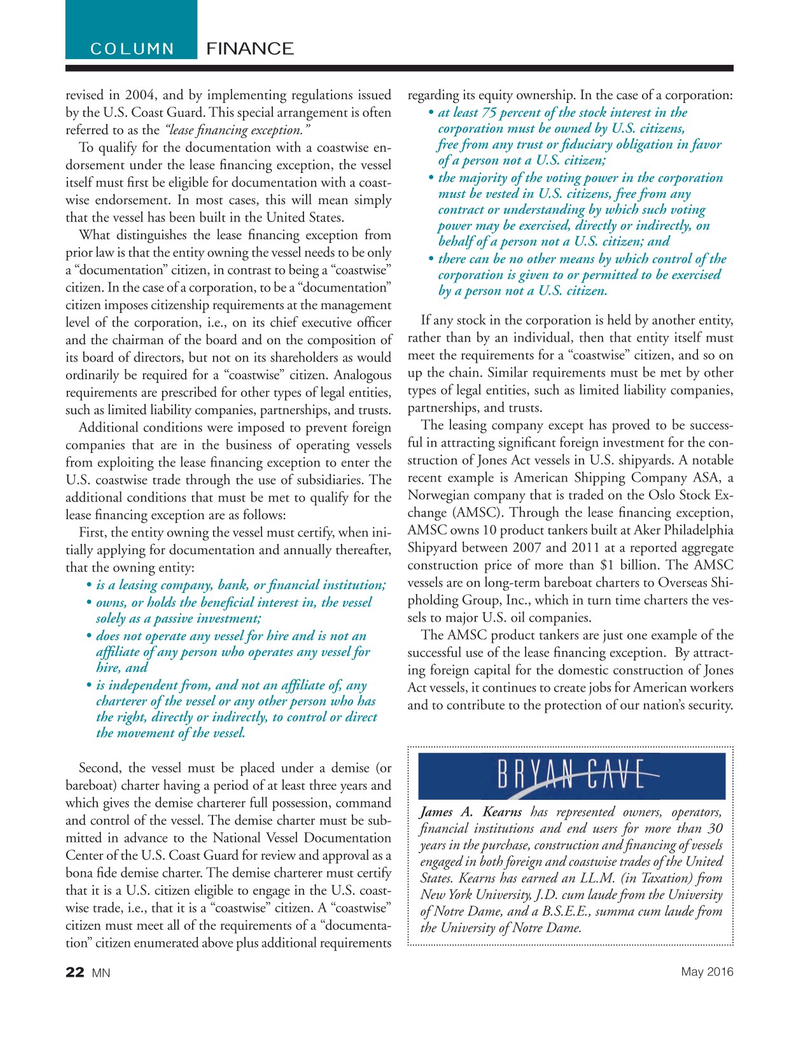
Page 22: of Marine News Magazine (May 2016)
Inland Waterways
Read this page in Pdf, Flash or Html5 edition of May 2016 Marine News Magazine
COLUMN FINANCE revised in 2004, and by implementing regulations issued regarding its equity ownership. In the case of a corporation: by the U.S. Coast Guard. This special arrangement is often • at least 75 percent of the stock interest in the corporation must be owned by U.S. citizens, referred to as the “lease ? nancing exception.” free from any trust or ? duciary obligation in favor
To qualify for the documentation with a coastwise en- of a person not a U.S. citizen; dorsement under the lease ? nancing exception, the vessel • the majority of the voting power in the corporation itself must ? rst be eligible for documentation with a coast- must be vested in U.S. citizens, free from any wise endorsement. In most cases, this will mean simply contract or understanding by which such voting that the vessel has been built in the United States.
power may be exercised, directly or indirectly, on
What distinguishes the lease ? nancing exception from behalf of a person not a U.S. citizen; and prior law is that the entity owning the vessel needs to be only • there can be no other means by which control of the a “documentation” citizen, in contrast to being a “coastwise” corporation is given to or permitted to be exercised citizen. In the case of a corporation, to be a “documentation” by a person not a U.S. citizen.
citizen imposes citizenship requirements at the management
If any stock in the corporation is held by another entity, level of the corporation, i.e., on its chief executive of? cer and the chairman of the board and on the composition of rather than by an individual, then that entity itself must its board of directors, but not on its shareholders as would meet the requirements for a “coastwise” citizen, and so on ordinarily be required for a “coastwise” citizen. Analogous up the chain. Similar requirements must be met by other requirements are prescribed for other types of legal entities, types of legal entities, such as limited liability companies, partnerships, and trusts.
such as limited liability companies, partnerships, and trusts.
The leasing company except has proved to be success-
Additional conditions were imposed to prevent foreign companies that are in the business of operating vessels ful in attracting signi? cant foreign investment for the con- from exploiting the lease ? nancing exception to enter the struction of Jones Act vessels in U.S. shipyards. A notable
U.S. coastwise trade through the use of subsidiaries. The recent example is American Shipping Company ASA, a additional conditions that must be met to qualify for the Norwegian company that is traded on the Oslo Stock Ex- change (AMSC). Through the lease ? nancing exception, lease ? nancing exception are as follows:
AMSC owns 10 product tankers built at Aker Philadelphia
First, the entity owning the vessel must certify, when ini- tially applying for documentation and annually thereafter, Shipyard between 2007 and 2011 at a reported aggregate construction price of more than $1 billion. The AMSC that the owning entity: vessels are on long-term bareboat charters to Overseas Shi- • is a leasing company, bank, or ? nancial institution; pholding Group, Inc., which in turn time charters the ves- • owns, or holds the bene? cial interest in, the vessel solely as a passive investment; sels to major U.S. oil companies.
• does not operate any vessel for hire and is not an The AMSC product tankers are just one example of the af? liate of any person who operates any vessel for successful use of the lease ? nancing exception. By attract- hire, and ing foreign capital for the domestic construction of Jones • is independent from, and not an af? liate of, any
Act vessels, it continues to create jobs for American workers charterer of the vessel or any other person who has and to contribute to the protection of our nation’s security.
the right, directly or indirectly, to control or direct the movement of the vessel.
Second, the vessel must be placed under a demise (or bareboat) charter having a period of at least three years and which gives the demise charterer full possession, command
James A. Kearns has represented owners, operators, and control of the vessel. The demise charter must be sub- ? nancial institutions and end users for more than 30 mitted in advance to the National Vessel Documentation years in the purchase, construction and ? nancing of vessels
Center of the U.S. Coast Guard for review and approval as a engaged in both foreign and coastwise trades of the United bona ? de demise charter. The demise charterer must certify
States. Kearns has earned an LL.M. (in Taxation) from that it is a U.S. citizen eligible to engage in the U.S. coast-
New York University, J.D. cum laude from the University wise trade, i.e., that it is a “coastwise” citizen. A “coastwise” of Notre Dame, and a B.S.E.E., summa cum laude from citizen must meet all of the requirements of a “documenta- the University of Notre Dame.
tion” citizen enumerated above plus additional requirements
May 2016 22 MN
MN May16 Layout 18-33.indd 22 4/20/2016 1:53:06 PM

 21
21

 23
23
